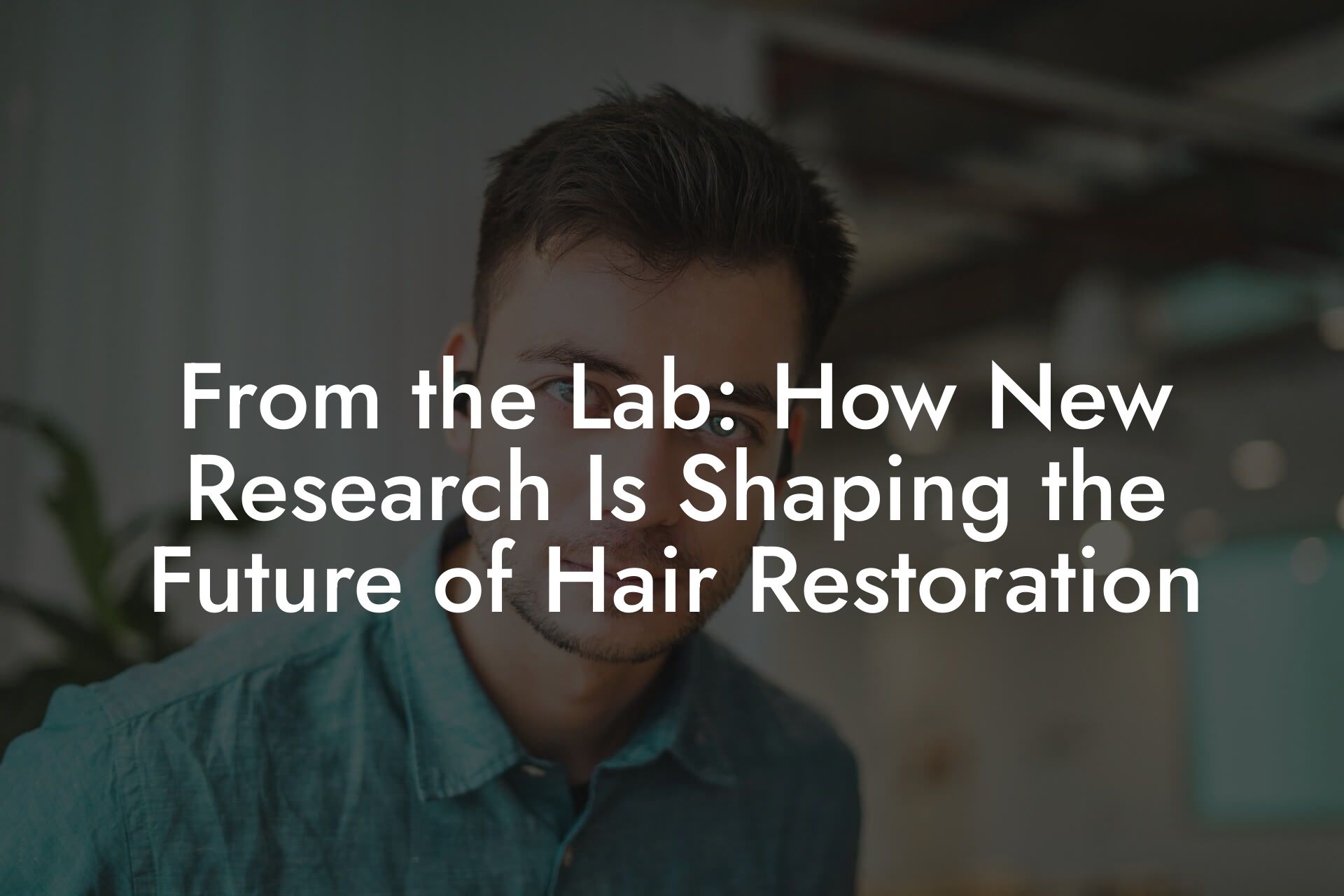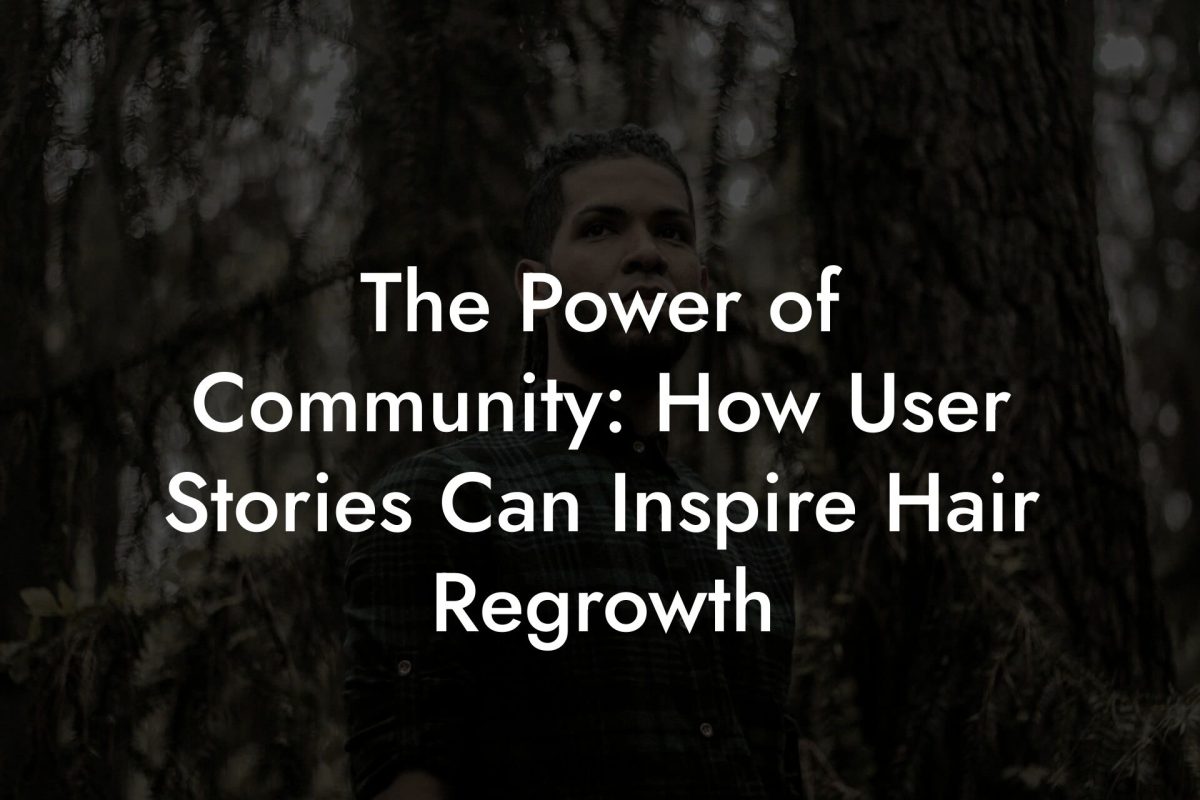Hair Loss Library
From the Lab: How New Research Is Shaping the Future of Hair Restoration

Picture this: a future where losing your hair is as outdated as dial-up internet. Welcome to the cutting-edge realm of hair restoration research—where labs buzz with innovative experiments, scientific breakthroughs, and a playful determination to help you reclaim your crowning glory. Whether you're a tech-savvy millennial or a Gen Z trailblazer, Mane Matrix is your go-to source for decoding the latest findings, all without the awkward doctor visits or wallet-draining consultations. Get ready to dive into a world where hair loss is tackled head-on with humor, creativity, and a splash of lab magic.
Breaking the Mold: What’s New in Hair Restoration Research?
The journey from bald to bold has come a long way since ancient remedies and questionable potions. Today, hair restoration research is a vibrant mix of state-of-the-art technology, genetic wizardry, and a dash of holistic charm. Researchers are not just fixing hair—they’re reimagining the entire process, employing innovative techniques that blend science and art. This isn’t your grandfather’s remedy; this is an era where CRISPR gene editing, stem cell unlocks, and bioengineered treatments are making wild promises a reality.
In the lab, brilliant minds are working on ways to reawaken dormant hair follicles, modify genetic triggers, and use the body's own healing mechanisms to inspire hair regrowth. Imagine a scenario where your hair’s comeback story is as epic as your favorite Netflix series. Cutting-edge studies now explore everything from prostaglandin receptor modulation to platelet-rich plasma (PRP) injections, aiming to create custom-tailored treatments that defy the typical one-size-fits-all approach.
The result? A future where hair restoration is not only more effective but also packed with the excitement of scientific discovery. And if you thought science was dull, wait until you see how these breakthroughs translate into real results—with a touch of humor and a lot of heart.
Inside the Lab: Where Science Meets Hair
Step into the lab—a bustling arena where petri dishes, microscopes, and innovative algorithms come together to rewrite the rules of hair restoration. Here, the focus isn’t solely on combatting hair loss; it’s on understanding its root causes and intervening at the cellular level. Whether it’s targeting inflammatory pathways, restoring the vitality of hair follicle niches, or discovering new growth factors, the lab is the birthplace of tomorrow’s must-have hair care techniques.
Microscopic Marvels and Cellular Science
Researchers are now applying advanced imaging techniques to peer into the life of a hair follicle micrometer by micrometer. Gone are the days when a transdermal patch was the height of innovation—instead, scientists are investigating how stem cells and growth factors interact to spark regeneration. Using sophisticated assays and computerized models, these microscopic marvels reveal how even the smallest cellular changes can make a big difference in your hair restoration journey.
Breakthroughs in Growth Factor Research
Growth factors such as VEGF (vascular endothelial growth factor) and PDGF (platelet-derived growth factor) are gaining traction as superheroes of hair regrowth. Ingenious research projects are honing in on these proteins to stimulate hair follicle activation and extend the growth phase of your hair cycle. With a few strategic tweaks, the idea is to create treatments that jump-start your follicles from a dormant state to full-blown hair production.
Bioactive Compounds and Molecular Interventions
The infusion of bioactive compounds in topical applications and injectables is reshaping the way we approach hair care. By harnessing specific peptides, antioxidants, and natural botanicals, scientists are engineering formulas that work deep within the skin. These compounds not only boost the health of your follicles but also create an environment that resists the damaging effects of stress and environmental factors.
Precision Medicine and Genetics: Unlocking Your Hair's DNA
The future of hair restoration is personal—and it all starts with your genes. Precision medicine is transforming the field by taking into account individual genetic differences. Instead of a blanket treatment that works for everyone (or mostly everyone), we’re moving towards a custom-tailored approach that targets the specific genetic markers associated with hair loss.
Decoding the Genetic Blueprint
Recent advancements in genetic testing have allowed scientists to pinpoint the malfunctioning genes that contribute to hair thinning and loss. By understanding how genes like AR (androgen receptor) influence hair follicle behavior, researchers can develop targeted treatments that may inhibit the negative effects of hormones like dihydrotestosterone (DHT). Think of it as a personalized game plan for your follicles, designed uniquely for you.
The Rise of Gene Therapy in Hair Restoration
Gene therapy isn’t just for rare diseases anymore—it’s stepping into the spotlight as a potential solution to hair loss. Through delicate gene editing techniques like CRISPR, scientists are exploring ways to tweak the genetic code, softening the impact of harmful mutations and even reviving idle hair follicles. While still in the early stages, these promising studies could one day offer treatments that tackle hair loss at its source, carving a path toward truly personalized restoration.
Precision Treatments in Action
Imagine walking into your hair clinic and receiving a treatment plan that feels like it was designed specifically for your DNA. With precision medicine, that future is closer than ever. From bespoke topical solutions to customized injection formulas, the innovations emerging from genetic research are set to transform how we understand and treat hair loss. It’s a brave new world where your hair’s destiny is written in its genes—one that promises more effective, precise, and confidence-boosting outcomes.
From Buns to Bots: Technological Innovations in Hair Transplant Surgery
When science meets technology, the results are nothing short of revolutionary—especially in the field of hair restoration surgery. Gone are the clunky robots of sci-fi; welcome modern systems that enhance precision and efficiency, making hair transplant procedures faster, less invasive, and more natural than ever before.
The Role of Robotics in Hair Transplants
Robotic systems are stepping into the operating room with a promise to transform hair transplant procedures. These high-tech assistants can meticulously extract and implant hair follicles with a level of precision that minimizes damage to surrounding tissues. The benefits? Reduced recovery time, optimized survival rates for transplanted follicles, and results that look nothing like the “pluggy” hairlines of the past.
Computer-Assisted Mapping and Design
Imagine having a personal cartographer for your scalp. With computer-assisted mapping, surgeons can plan the optimal hairline and implantation strategy that suits your unique facial structure. This technology uses detailed algorithms to analyze your hair density and growth patterns, ensuring that every follicle is placed with artistic flair and scientific precision. The result is a hairline that not only looks natural but is perfectly aligned with your overall aesthetic.
Enhanced Recovery with Minimally Invasive Techniques
Thanks to advancements in surgical techniques and laser-assisted procedures, modern hair restoration is all about minimal invasiveness and maximum results. These techniques reduce trauma to your scalp, leading to faster healing and less downtime. It’s like upgrading from a clunky old smartphone to the latest model—everything just works smoother, faster, and with far less hassle.
Platelet-Rich Plasma (PRP) and Stem Cell Therapy: Modern Miracles?
If you’ve ever wondered whether your blood could be the secret weapon in your hair restoration journey, you’re not alone. Platelet-rich plasma (PRP) and stem cell therapies are two of the most talked-about innovations in the field, drawing on the body’s natural resources to encourage hair regrowth.
The Science Behind PRP
PRP therapy involves drawing a small sample of your blood, processing it to concentrate the platelets, and then injecting this potent mixture into your scalp. These platelets are rich in growth factors that can stimulate hair follicles, promoting regeneration and diminishing inflammation. Studies have shown that regular PRP sessions can significantly improve hair density and thickness, making it a favorite among those pursuing non-surgical solutions.
Stem Cell Breakthroughs: Reviving Dormant Follicles
Stem cell therapy takes regeneration to a whole new level by harnessing the potential of undifferentiated cells to repair and renew damaged tissues. In the context of hair restoration, stem cells can be used to trigger the growth phase in dormant follicles, effectively recharging them for renewed hair production. Early studies have reported promising results, paving the way for treatments that blend cellular biology with regenerative medicine.
Combining Therapies for Synergistic Effects
Some of the most exciting research now explores the benefits of combining PRP and stem cell therapies. The idea is to create a synergistic treatment that maximizes the natural healing properties of both methods. Imagine a therapeutic cocktail that boosts your follicles from every angle—this holistic, lab-tested approach might just be the future gold standard for hair restoration.
Integrative Approaches: When Lab Science Meets Natural Wisdom
As cutting-edge research continues to break barriers in hair restoration, there’s also a growing recognition of the benefits of integrative and holistic approaches. These methods complement high-tech treatments with natural lifestyle adjustments, ensuring that your hair restoration journey is as balanced and sustainable as possible.
Diet, Supplements, and Hair Health
It turns out that your diet matters—a lot. Nutrient-dense foods rich in vitamins, minerals, and antioxidants play a pivotal role in nourishing your hair from the inside out. Omega-3 fatty acids, biotin, and vitamin D are just a few of the key players in supporting hair follicle health. Many scientists now advocate for hair-friendly diets that deliver the essential building blocks your scalp needs to thrive.
Stress Management and the Mind-Body Connection
You’ve probably heard the saying “stress makes you lose more than just sleep.” Chronic stress can wreak havoc on your hair cycle, leading to telogen effluvium—a temporary but distressing form of hair loss. That’s why modern treatment plans often include mindfulness practices, yoga, or even simple breathing exercises. These mind-body techniques not only help reduce stress but also create an optimal environment for hair regrowth.
Topical Natural Remedies Meet Scientific Rigor
While clinical treatments work their magic from within, topical applications infused with natural ingredients can play a critical role as well. Many formulations now combine botanical extracts with scientifically proven compounds to boost scalp circulation and fortify hair structure. It’s a blend of nature and innovation that gives your hair both the cellular lift of lab science and the nurturing touch of nature.
Real-Life Transformations: Case Studies in Hair Restoration
The proof, as they say, is in the pudding—or in this case, the thriving hairlines! Across the globe, real men are experiencing life-changing transformations thanks to these revolutionary approaches. Let’s take a look at a few case studies that illustrate how new research is turning bald spots into badges of honor.
Case Study 1: From Stress-Induced Thinning to Lush Locks
Meet Alex, a 32-year-old digital nomad whose relentless work schedule and high-stress lifestyle led to unexpected hair thinning. After discovering a treatment plan that combined precision PRP sessions with lifestyle adjustments and dietary overhauls, Alex started to see remarkable improvements. Within months, his hair density increased, his confidence soared, and his once-fearful glances in the mirror transformed into a nod of approval. Alex’s journey perfectly encapsulates how a multi-pronged approach can reverse the damage of stress-induced hair loss.
Case Study 2: Gene Therapy and Robotics in Harmony
Then there’s Marcus, a 40-year-old tech enthusiast whose family history of male pattern baldness was a looming specter over his identity. Eager to try something radically different, he enrolled in a clinical trial exploring gene therapy combined with robotic hair transplant surgery. The results? Marcus witnessed a gradual revival of hair growth as the precise robotic extraction techniques minimized trauma and maximized follicle survival. His treatment plan, tailored to his unique genetic profile, proved that sometimes the perfect blend of tradition and technology can lead to astonishing outcomes.
Case Study 3: Stem Cell Secrets and The Natural Edge
Finally, consider Ryan, a 28-year-old fitness buff who was determined to tackle hair loss head-on. Combining state-of-the-art stem cell therapy with a rigorous workout regime, a nutrient-dense diet, and mindfulness techniques, Ryan embarked on a diverse treatment journey. Not only did his hair regrowth surpass expectations, but his overall wellness improved dramatically. His story is a testament to the power of integrative care, where lab breakthroughs meet everyday lifestyle choices to create a winning formula for hair restoration.
These case studies aren’t just anecdotes—they’re proof that holistic, scientifically grounded approaches can rewrite the narrative of hair loss. The future of hair restoration is here, and it’s as diverse and dynamic as the individuals who stand to benefit from it.
Creating Your Personalized Hair Restoration Journey
Just as no two strands of hair are exactly alike, your path to regaining a fuller mane should be just as unique. Crafting your personalized plan starts with understanding the interplay between science, technology, and lifestyle choices that affect hair health.
Step 1: A Comprehensive Assessment
Begin by hitting the lab (or your trusted hair restoration expert) for a detailed assessment. This isn’t just about examining your scalp—it’s about understanding your genetic predispositions, environmental stressors, and lifestyle habits that are influencing your hair’s health. A thorough analysis sets the foundation for a tailored approach that works specifically for your unique pattern of needs.
Step 2: Setting Clear, Ambitious Goals
Whether you’re looking to reverse thinning, boost density, or simply maintain what you’ve got, setting realistic and measurable goals will keep you on track. Think of your goals as milestones on a roadmap—each one a step closer to the vibrant hair you deserve. A detailed treatment plan might include a mix of PRP sessions, gene-targeted medications, and lifestyle tweaks that collectively spark hair regrowth.
Step 3: Integrative Treatment Options
Embrace a multi-dimensional approach. Combine conventional medical treatments like robotic transplants or PRP injections with advanced options such as gene therapy and stem cell treatments. Add to that a supportive regime of dietary adjustments, stress management, and topical natural remedies, and you’ve got a blueprint for lasting hair restoration success.
Step 4: Track Your Progress
Consistency is key. Use digital apps, journals, or even a dedicated timeline to document your treatment sessions and any changes you notice. Regular feedback sessions with your specialist (or even self-check-ins) can help you tweak your regimen to ensure optimal progress. This isn’t just about turning back the clock—it’s about setting a sustainable pace for your hair’s new life.
Step 5: Flexibility and Continuous Improvement
Science moves fast, and your treatment plan should too. As new research surfaces, be open to incorporating the latest breakthroughs into your routine. Your personalized approach is dynamic—adjust, experiment, and adopt new practices as your hair restoration journey evolves.
Your hair restoration journey is as much a testament to your individuality as it is to modern science. Tailored to your specific needs, this roadmap combines the power of lab innovations with everyday lifestyle improvements—all designed to help you achieve a fuller, more confident future.
Resources and Community Support: Your Next Steps
The world of hair restoration isn’t traveled alone. With the latest research constantly reshaping the landscape, community support and targeted resources are key to navigating your journey successfully.
Here at Mane Matrix, you have access to a vibrant network of experts, peers, and digital tools that keep you informed about the most recent breakthroughs, treatment options, and lifestyle adjustments tailored for hair restoration. From detailed blog posts and webinars to interactive Q&A sessions with specialists, this community is built to empower you every step of the way.
Consider subscribing to expert newsletters, joining social media groups for firsthand experiences, or even participating in clinical studies and trials when the opportunity arises. Knowledge is power, and staying connected with fellow hair restoration warriors can provide tips, encouragement, and continuous motivation. Whether you’re exploring gene therapy breakthroughs or debating the merits of PRP versus traditional methods, community support is a priceless resource on your quest for vibrant hair.
Frequently Asked Questions About Hair Restoration Research
We know you have questions about the rapidly evolving world of hair restoration. Here are some of the most common questions answered to help you navigate this innovative landscape:
1. What are the latest breakthroughs in hair restoration?
Recent breakthroughs include advancements in platelet-rich plasma (PRP) therapy, stem cell treatments, gene therapy, and the integration of robotics and computer-assisted mapping in hair transplant procedures. These innovations aim to rejuvenate dormant hair follicles and provide more natural, efficient results.
2. How does gene therapy work in treating hair loss?
Gene therapy in hair restoration focuses on addressing the genetic factors that contribute to hair loss. Techniques such as CRISPR are being researched to modify problematic genes and stimulate hair follicle activation for natural regrowth.
3. Can PRP and stem cell therapies really reverse hair loss?
While results can vary, many studies have shown that PRP and stem cell therapies can stimulate hair regrowth by using the body’s natural healing mechanisms. They work best when integrated into a personalized treatment plan that considers your unique needs.
4. Are robotic hair transplants safe and effective?
Robotic hair transplants have advanced significantly over recent years. They offer improved precision and reduced trauma during the procedure, leading to faster recovery and more natural-looking results.
5. How can lifestyle changes help with hair restoration?
A nutrient-rich diet, stress management, and consistent self-care routines are critical. These lifestyle adjustments can complement advanced treatments, supporting robust hair follicle health and overall scalp wellness.
6. What role does precision medicine play in hair restoration?
Precision medicine tailors treatment plans based on individual genetic profiles and health data, ensuring that therapeutic interventions, such as gene therapy and targeted medications, are customized to your specific needs.
7. How do I know which hair restoration treatment is right for me?
Consulting with a hair restoration specialist who can perform a comprehensive assessment, including genetic and lifestyle evaluations, is the best way to determine the most effective treatment options for your unique situation.
8. Is research on hair restoration widely accessible?
Absolutely. Many cutting-edge studies and clinical trials are published in scientific journals and shared through expert communities, ensuring that both professionals and patients remain well informed about the latest innovations.
Your Path to Bold, Scientific Hair Restoration
The future of hair restoration is no longer confined to mythic remedies or expensive consultations. With the fusion of groundbreaking lab research, technological innovations, and a personalized approach to healthcare, your journey toward a fuller, healthier head of hair is well within reach.
Embrace the science, celebrate the breakthroughs, and dare to dream of a time when every strand is a testament to innovation and individuality. Whether it’s the precision of robotic surgery, the promise of gene therapy, or the natural boost of PRP and stem cell treatments, each new discovery inches us closer to a reality where hair loss becomes a fading memory.
As you venture forward, remember that the path to hair restoration is as dynamic and unique as the individual behind every strand. Stay informed, remain curious, and let the blend of science and self-care propel you toward a future where your hair is a crown of confidence and creativity. Your journey to bold, scientifically empowered hair restoration starts now—step in and let your true self shine.
If you loved this article... Dive deeper into the world of mens hair loss with our most popular sections. If there is anything you think is missing or anything you would love for us to write about, just give us a shout.
Expert Interview: Leading Dermatologists Discuss Men’s Hair Loss Solutions
Case Study: How One Man Reversed His Hair Loss Naturally
Hair Loss FAQs: Your Top Questions Answered by Experts
Behind the Scenes: A Day in the Life of a Hair Transplant Surgeon
Success Stories: Real Men Share Their Hair Regrowth Journeys
Debunking Hair Loss Myths: Insights from Top Trichologists
The Role of Genetics: Experts Weigh in on Inherited Hair Loss
How Lifestyle Changes Made a Difference: Inspiring Hair Regrowth Stories
In-Depth Q&A: What Every Man Should Ask Before a Hair Transplant
Roundtable: Experts Debate the Best Non-Surgical Hair Loss Treatments
From the Lab: How New Research Is Shaping the Future of Hair Restoration
Personal Journeys: Overcoming Hair Loss and Embracing Confidence
The Ultimate Hair Loss Q&A: Everything You Need to Know
An Insider’s Look: What Hair Loss Clinics Don’t Tell You
Expert Tips for Maximizing Hair Restoration Treatment Results
Hair Loss in Different Age Groups: What the Experts Recommend
Addressing Scalp Concerns: A Comprehensive FAQ for Men
Analyzing Competitor Gaps: How Mane Matrix Stands Out in Hair Loss Content
The Power of Community: How User Stories Can Inspire Hair Regrowth
Future Forecast: What Experts Predict for Men’s Hair Loss Treatments
















